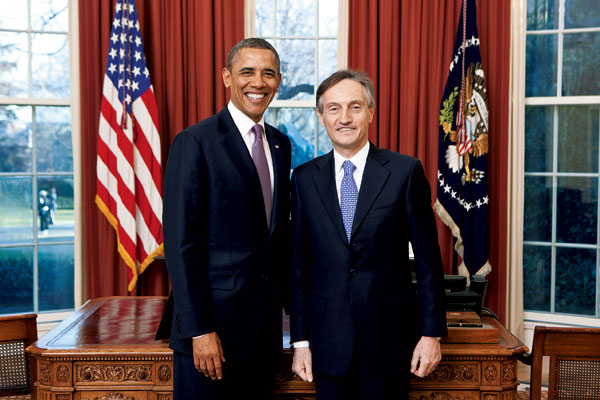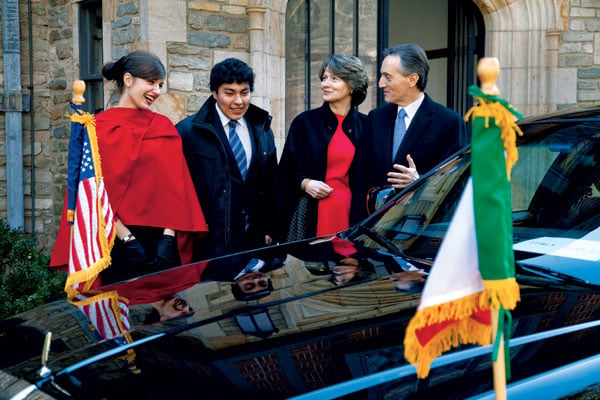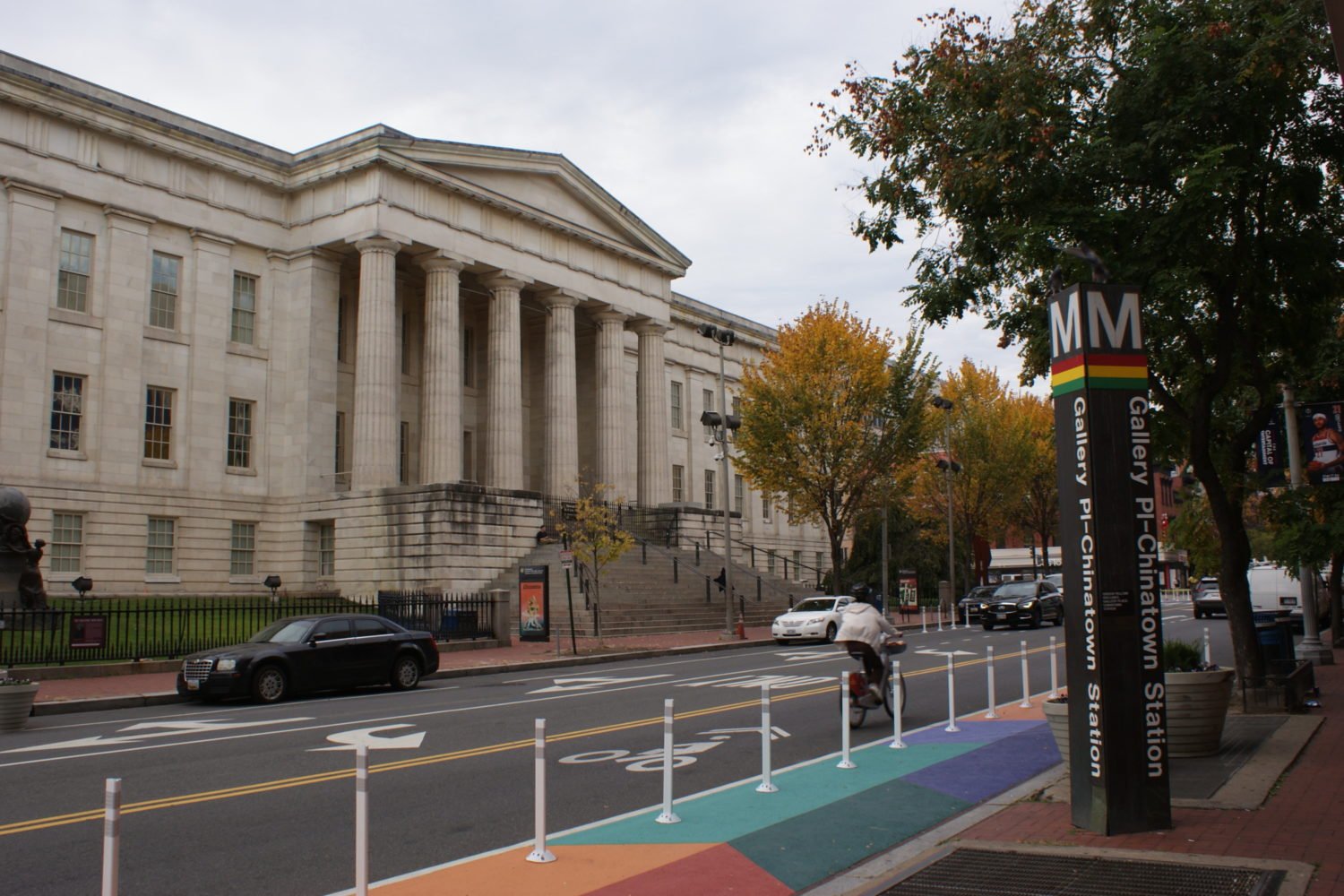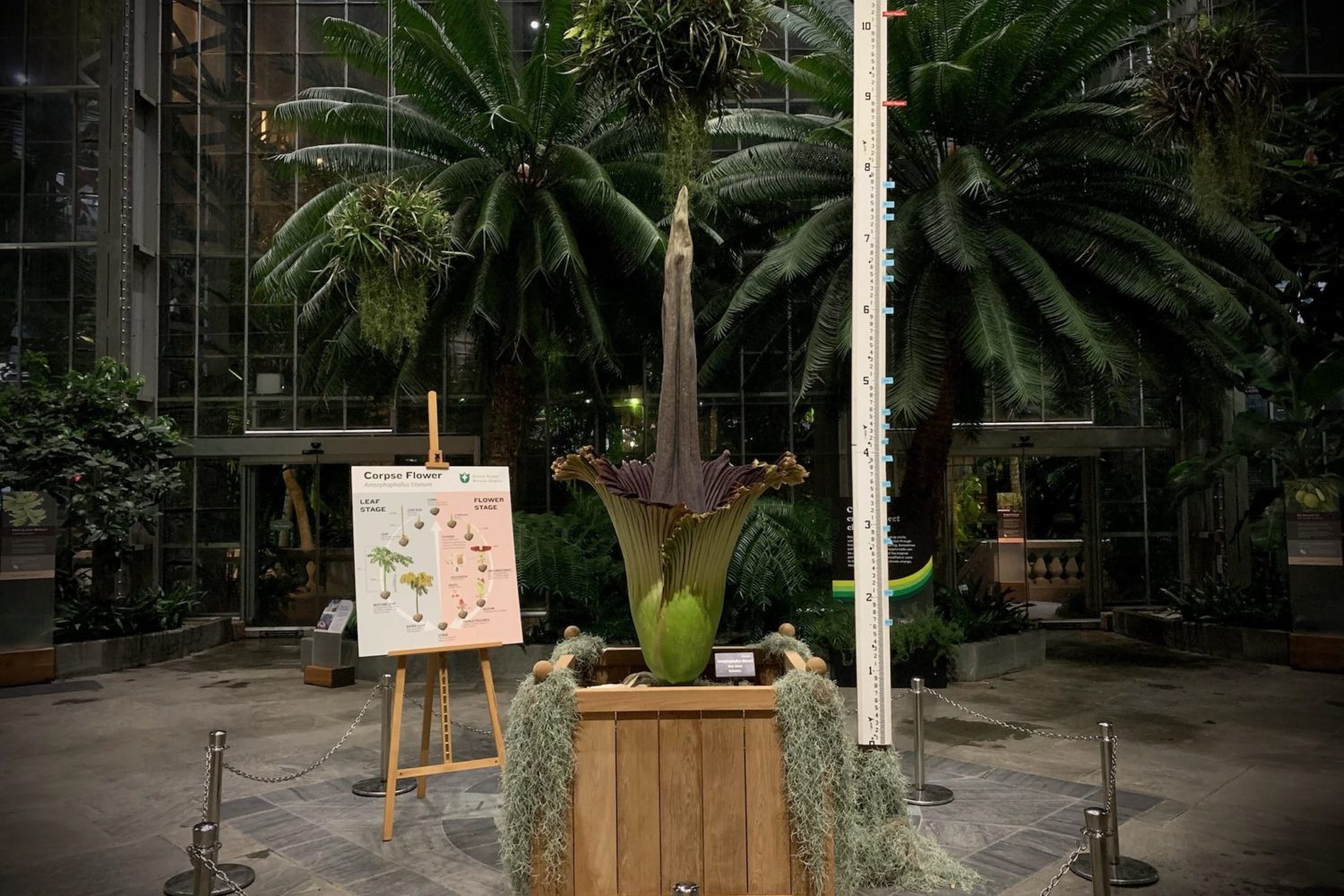
President Obama met with Bisogniero and his family in the Oval Office. Photograph by Lawrence Jackson/The White House.
The black sedan arrives at Villa Firenze a bit early, one of the rare moments in this day that won’t go precisely according to plan. A diplomatic car doesn’t drive around town displaying a national flag unless its representative is actually inside the car. So the driver stops short of the residence, gets out, and slips a small Italian flag into a holster on the front of the sedan. Then he pulls into the long driveway and up to the ambassador’s front door.
A second sedan pulls in behind it to carry Bisogniero’s children. The ambassador and his wife climb into the back seat of the front car and make the five-mile trip to the White House. The rest of the day will be an exercise in punctuality and patience.
Washington’s Top Ambassadors
Where ambassadors stand on the diplomatic ladder has nothing to do with the size or influence of their countries. The order of precedence, a centuries-old tradition, ranks foreign ambassadors to the United States according to when they arrived in Washington to assume their official duties. Here are the top ten in descending order along with when they arrived.
|
1. DjiboutiRoble Olhaye |
2. SingaporeHeng-Chee Chan |
|
3. YemenAbdulwahab A. Al-Hajjri |
4. PalauHersey Kyota |
|
5. Democratic Republic of the CongoFaida Mitifu |
6. LiechtensteinClaudia Fritsche |
|
7. TurkmenistanMeret Bairamovich Orazov |
8. BeninSegbe Cyrille Oguin |
|
9. Republic of the CongoSerge Mombouli |
10. KuwaitSheikh Salem Abdullah Al Jaber Al-Sabah |
At the southwest gate, the ambassador’s car queues up in the order of precedence, behind the fleet of flag-bearing sedans carrying the 12 other ambassadors who arrived in Washington before Bisogniero. Confirming that national influence has no bearing on who gets to see the President first, Sir Peter Westmacott, Her Majesty’s ambassador to the United States, is at the end of the line.
The cars pull onto the White House grounds one by one. Each ambassador waits in his idling car until his or her turn comes. Just before 2:30, Bisogniero’s car slowly winds its way up the driveway to the South Portico, the diplomatic entrance of the White House. The United States Army Band Herald Trumpets plays a series of fanfares, including “Call to Statesmanship” and “Salute to a New Beginning.”
Bisogniero steps out of the car to a red carpet flanked by the US and Italian flags. Ambassador Capricia Marshall, the chief of protocol, is there to shake his hand and welcome him to the White House. While the protocol office has been busy for months planning the credentialing ceremony, it will fall mostly to Marshall to ensure that it comes off without a misstep.
Marshall–who was named social secretary in the Clinton White House when she was only 32–has memorized the names and faces of all the ambassadors, their spouses’ names, their children’s names, the names of each of their guests. Her staff has drawn up flash cards with all the officials’ particulars, along with a headshot the size of a passport photo. She will guide each ambassador, along with the family, through a maze of rooms and hallways before ending up in the Oval Office.
Marshall takes Bisogniero first to the Diplomatic Reception Room. In 1837, this space was converted from a basement area used for polishing silver into the White House boiler room. A century later, it’s where Franklin Roosevelt held his fireside chats.
Here, a protocol officer relieves Marshall and escorts Bisogniero farther into the White House, first outside, along the colonnade and past the rose garden, and then into the Cabinet Room, where Bisogniero signs the President’s guest book. Next, he crosses the hall to the Roosevelt Room, the customary waiting area for foreign delegations, where Bisogniero can relax, take some refreshments, and mingle with his fellow ambassadors. In the early 1900s, this room was the site of the Oval Office. After FDR moved it to the southeast corner of the White House in 1934, he installed an aquarium and dubbed this the Fish Room.
It takes precise timing, and constant motion, to keep the flow of foreign dignitaries from ending up in a traffic jam somewhere between the south entrance and the West Wing. Marshall has only three minutes to bring each ambassador from the portico to the Diplomatic Reception Room before turning around and receiving the next ambassador as his or her car pulls up. While she was inside with Bisogniero, Italy’s flag was removed from its stand at the entrance and replaced with Micronesia’s.
When Sir Peter arrives at 2:40, the chief of protocol escorts him personally to the West Wing. (It’s one of the few times when being last in the order has advantages.) In the Roosevelt Room, Marshall, acting as both hostess and stage manager, rehearses the big moment with the assembled crowd.
“I probably walk through the process at least two or three times with them,” she says. But sometimes, “at the moment that they’re greeting the President, it is as if they’ve never been told anything before.”
“It’s a unique moment,” Marshall explains. “You’re standing in the hallway outside the Oval Office, and then you can see the doorknob turn . . . and then the President is standing right there.” This is the point at which, on occasion, a polished globetrotting diplomat has turned to jelly and forgotten his wife’s name. Marshall steps in: “Mr. President, may I introduce Mrs. . . . .”
As Bisogniero prepares to enter the Oval Office, he holds onto a blue folder bearing three documents: a letter recalling his predecessor, Terzi, from Washington; written remarks from Bisogniero to Obama; and a letter of credence from the president of Italy and the foreign minister to Obama, acknowledging Bisogniero as the country’s official representative to the US. These are originals, not copies. And Bisogniero must deliver them personally to the President.
He presents his documents, and Obama reciprocates with his own. They exchange brief remarks; Bisogniero conveys the best wishes of his president, of Prime Minister Mario Monti, and of Foreign Minister Terzi. Obama asks that the ambassador convey the same to them. With the formalities complete, Bisogniero introduces his family.
“The President was warm and welcoming in talking to my whole family–far beyond what we expected,” Bisogniero says later. “He made us feel as if he had nothing else on his to-do list that day except to make me, my wife, and Serena and Giampaolo feel at home in the most famous house in America.”
Bisogniero’s sendoff is as grand as his arrival. It’s back through the White House to the south entrance. A military honor cordon lines the drive. The sedan makes its way out the gate and returns to Villa Firenze. The family won’t stay long. Tonight Bisogniero and his wife will fly back to Brussels and to the daunting reality every new Washingtonian must face: a houseful of moving boxes.
This article appears in the March 2012 issue of The Washingtonian.




























